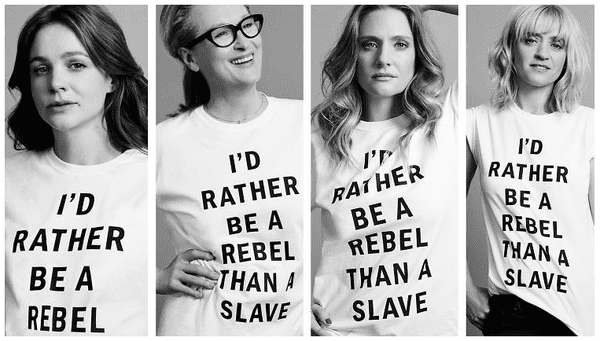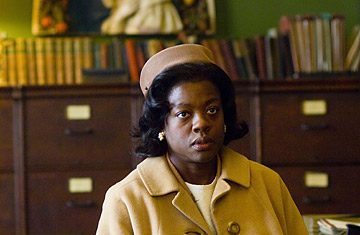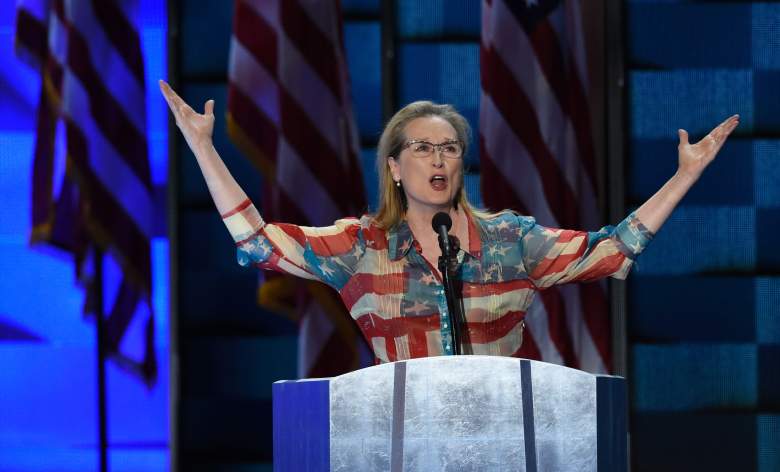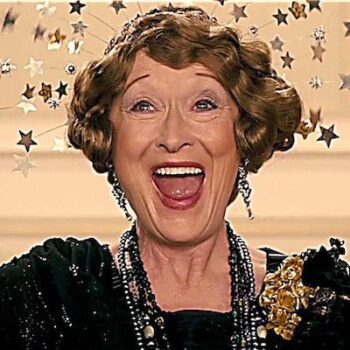
I recently saw a preview for the new film Florence Foster Jenkins, and was immediately filled with racial déjà vu.
Foster Jenkins was a wealthy woman who could not sing but used her inherited wealth and tremendous self-confidence to build a singing career for herself in the 1940s—even headlining a concert at Carnegie Hall.
Call it #beckywiththebadvoice. The trailer made me think of the recent Abigail Fisher Supreme Court Case against affirmative action. Fisher was a white student who felt she deserved to attend the University of Texas Austin despite her mediocre grades. When she didn’t get in, she blamed affirmative action and took her case all the way to the Supreme Court where she was defeated in a 4–3 decision.
In the Florence Foster Jenkins trailer, Meryl Streep is playing a wealthy white woman exercising her privilege to have a concert career despite a demonstrable and universally recognized lack of talent and skill.
The trailer portrays this quest as some kind of hero’s journey. The tagline proclaims, “Based on the inspiring true story.” Clearly, the audience is meant to cheer Foster Jenkins’s chutzpah.
Yet another Meryl Streep film that privileges a perniciously white brand of feminism.
It reminded me of every argument I’d ever had with my mother about Meryl Streep when I was growing up. My mother was white and loved Meryl Streep. I am mixed-race, Chinese and white, and self-identify as Asian American. My mother could not understand why I did not love Meryl Streep movies the way she did.
Once we were talking about my paternal grandmother and what a movie her life would make. Nai-nai had lived a life of epic struggles—against patriarchal attitudes as well as the invading Japanese Army in order to protect her family during World War II. Nobody was making any kind of movie about my grandmother, but this was the kind of game we liked to play, imagining if our own family stories became movies and who would play the characters. Perhaps every family on earth plays this kind of game while watching movies together on the couch.
My mother felt Meryl Streep could play Nai-nai.
“She can’t,” I said. “She’s white and Nai-nai’s Chinese.”
“Oh, Meryl Streep could do it,” my mother insisted. “She could wear make-up and she could study the accent. She would do a great job!”
“But she shouldn’t!” I said. “A Chinese actress should play Nai-nai!”
But my mother could not be convinced otherwise. In her mind, Meryl Streep could play anyone.
And that is the biggest problems I have with Meryl Streep’s career and the kind of implicit white supremacist statement that it makes about which women’s stories matter and which racial phenotype is privileged in the telling of these stories.
Take, for example, her much vaunted talent at portraying different accents. In her roles she is frequently required to adopt different ethnicities and accents, which embodies the way white supremacy erases ethnic differences amongst Western European and Northern European peoples to create the constructed category of homogenous whiteness.
If nothing else, the recent Brexit vote in the United Kingdom shows that Europeans are not “white” but rather see themselves as different, separate ethnic and national groups. It is the US and our Founding Fathers who created this notion of whiteness that transcends old Europe’s ethnic divisions in order for white male property owners to fight against the racial others of the Americas.
However, people of color also exist in Europe and are European. One does not have to have Streep’s phenotype to be from Western or Northern Europe, yet a viewer would never know this from watching her films.
Streep’s career encapsulates the mid-to-late 20th century ideal of American whiteness as aspirational and as attainable. This one woman is literally allowed to embody all other European-derived ethnicities—English, German, South African, Australian, Danish, Italian, Polish, and of course European-American. But this privilege is not accorded to actresses who do not fall into the American-constructed category of “white.” For example, why can’t Salma Hayek play Italian? Or Vanessa Williams play English? Or Constance Wang play Scottish? Katie Leung is Scottish, and Gugu Mbatha-Raw is British, but American casting directors don’t think of them when casting European characters in American-produced movies. What makes casting Streep more credible as a European (or any American character) than any of them? As Lin-Manual Miranda’s Hamilton has shown the country, diverse racial casting of characters traditionally seen as “white”—such as America’s Founding Fathers—can be done successfully both from an artistic and financial point of view.
Thus, when critics continually refer to Streep’s roles as embodying simply femaleness rather than whiteness, they obscure the racialized nature of her performances. This racial blindspot came to light perhaps most glaringly during the publicity campaign for Suffragette (2015), in which Streep had a cameo playing Emmeline Pankhurst. Streep and her fellow white actresses donned T-shirts emblazoned with the Pankhurst quote: “I’d rather be a rebel than a slave,” apparently without realizing how very awful that would sound to African-American women (and others) for whom “rebels” and “slaves” evoked the Confederate South, rather than a call for universal women’s suffrage.
The T-shirt controversy raises the issue of self-awareness. Is Meryl Streep aware of her privilege and of her career as a societal force for white supremacy? Does she ever wonder why her characters tend to anchor plots and others, particularly women of color, do not?
For example, in 2008’s Doubt, Streep is centered as a white nun who suspects that a parish priest is molesting a black student. Viola Davis, who plays the anguished mother, has but one scene in the movie, which she plays without visible make-up, dressed in dumpy clothes, the embodiment of a supporting player. Yet despite Streep’s more showy tics—a broad “Bronx” accent, a tendency to make attention-grabbing facial expressions—Davis manages to make her character’s pain palpable as she argues with Streep’s Sister Aloysius. Davis must explain that she essentially doesn’t care if the priest may have ulterior motives because his interest in her son’s education is beneficial to the boy’s prospects for advancement.
Both actresses were nominated for many awards, and many critics praised both actresses, but no mainstream critics questioned why the white nun should be the center of this story. Why was her character’s journey more important than that of the black mother? Streep’s character does not change over the course of the film—she is a one-note villain who is certain that the white priest who takes the black male student under his wing must have ill intentions. But is hers the most important journey? Why not center the black working-class mother who may be making a deal with the devil when she allows the white priest to mentor her son?
This is not Meryl Streep’s fault per se, of course. She didn’t write the story, but it echoes an uncomfortable dynamic from a past film, Out of Africa (1985), in which she portrays a white Danish plantation owner whose privilege is literally exteriorized in the long white linen dresses that she wears on safaris in 1913 Kenya, at dinner parties, and while traipsing about her “farm” despite the fact that white cloth would show dirt more easily and would be very impractical in a dusty environment. She does no physical labor because she has black women and men and children to do it for her. Yet this film was seen as “feminist” at the time because it showed how author Karen Blixen managed to gain the respect of the white men around her—from the all-male British Club to the embattled British soldiers she brings supplies to in a grueling and dangerous trek across the country.
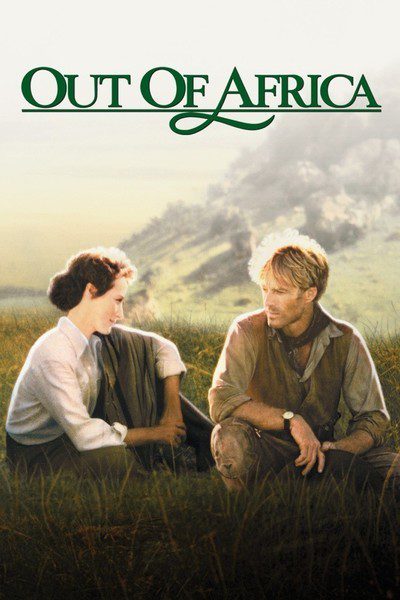 At best, the film is “white feminist” because it positions a white woman’s experiences as being equal in importance to the white men in her life. It shows white suffering—her battle with illness caused by an STD given to her by her white husband— as well as a white woman’s heroism during World War I, but it refuses to show the suffering of the black women who are obliged to work for her. What is their pain? What are their emotional lives like, their hopes and loves and family lives? The film never allows us to ask.
At best, the film is “white feminist” because it positions a white woman’s experiences as being equal in importance to the white men in her life. It shows white suffering—her battle with illness caused by an STD given to her by her white husband— as well as a white woman’s heroism during World War I, but it refuses to show the suffering of the black women who are obliged to work for her. What is their pain? What are their emotional lives like, their hopes and loves and family lives? The film never allows us to ask.
The erasure of black African women’s experiences in a movie literally called “Out of Africa” is so overt that it seems impossible today that any thinking person would not be aware of its racial biases. The supermodel Iman is relegated to a minor supporting character—why is she not at its center?
But Meryl Streep’s films continually center white female experiences at the expense of every woman of color. From her first film Julia (1977) to Falling in Love (1984) to The Devil Wears Prada (2006) to Julie & Julia (2009) to The Iron Lady (2011) to Ricki and the Flash (2015), decade after decade, film after film, women of color are simply absent (or completely marginalized) in Meryl Streep movies. Clearly Hollywood can only bear to give away so many breadcrumbs of power at a time. However, the erasure of women of color from Streep’s films erases the very nature of American society (as well as England in The Iron Lady) as a multi-racial society and instead contributes to the false idea that white women’s stories tell all women’s stories. That premise props up white supremacy in our culture.
Some of the erasures involve oddly monochromatic casting decisions. Why do Streep’s characters so rarely have friends, family, lovers, or even adversaries who are people of color? Beyond the casting issue, Streep’s characters (apart from Sophie in Sophie’s Choice) never have to deal with the issue of race and racism in her films, which hardly seems realistic. Why wasn’t Miranda Priestly in The Devil Wears Prada called out for employing only white people? Real editors in the fashion world have had to address this issue. How much more interesting (and less insipid) it would have been to have Karen Blixen address her complicity in the colonization of the Kenyan people in Out of Africa. And wouldn’t a rock-star societal rebel like Ricki in Ricki in the Flash have had friends and/or lovers of different races? What if this was one of the reasons she rebelled against living in white middle-class suburban Indianapolis? My point is that Meryl Streep movies could still exist as a star vehicle for a gifted actress if they also addressed intersectional issues of race and racism. Yet they do not.
Is Streep aware of her performances’ complicity in white supremacy? Actors have little say in whom is cast in their films, but some actors (like Brad Pitt, Angelina Jolie, Sandra Bullock, and Mindy Kaling, for example) have formed production companies that consciously seek to promote stories about people of color. Meryl Streep has spoken out publicly about the need for a museum of women’s history, but she has not spoken specifically about the struggles of women of color or about the intersectionality of race, class and gender in forming women’s struggles. Does she care?
This year, at the Berlinale International Film Festival in February, Streep was criticized for remarks she made that were dismissive of calls critiquing the lack of diversity on the all-white jury panel. When an Egyptian reporter asked her whether she would be able to understand films from North Africa and the Middle East, it was reported that, “Streep conceded that she is not very familiar with those regions. But, she added, ‘I’ve played a lot of different people from a lot of different cultures.’”
She went on to use a common misconception to justify the all-white jury and her role on it, claiming that somehow she would be able to understand the “core of humanity” that is seen as universal without understanding unique cultures and their cinematic histories.
“The thing that I notice is that there is a core of humanity that travels right through every culture and, after all, we’re all from Africa originally,” Streep was quoted as saying. “Berliners, we’re all Africans, really.”
Her flippant reference to every human on earth being from Africa originally and thus somehow part of a universal culture refuses to acknowledge actual differences in how different people from different cultures and ethnicities and races might choose to tell their own stories. (It also uncomfortably evokes one of her most overtly racially privileged films.) Her comment sounds suspiciously like “colorblindness,” that old trope that white people were taught as though the racial system that white men created didn’t actually create hierarchies that need to be actively dismantled. Refusing to see color does not mean someone has transcended racism. It means the “colorblind” person is refusing to acknowledge the harm that racism causes and is refusing to actively dismantle the systemic biases and structures that privilege white people over people of color.
Streep’s refusal to see race, to talk about race, and to work for diversity (she was on an all-white jury in an international film festival, after all!) embodies the racial problem at the center of her career. Her refusal to acknowledge the racism that props up her privilege results in a career which props up a constructed whiteness as the universal standard.
I, for one, will not be attending Florence Foster Jenkins. I wish Hollywood would look for movies that embody a real feminist story and not some tone-deaf excuse for white feminist privilege.
***
Image credits: Feature image, image 1, image 2, image 3, image 4.

